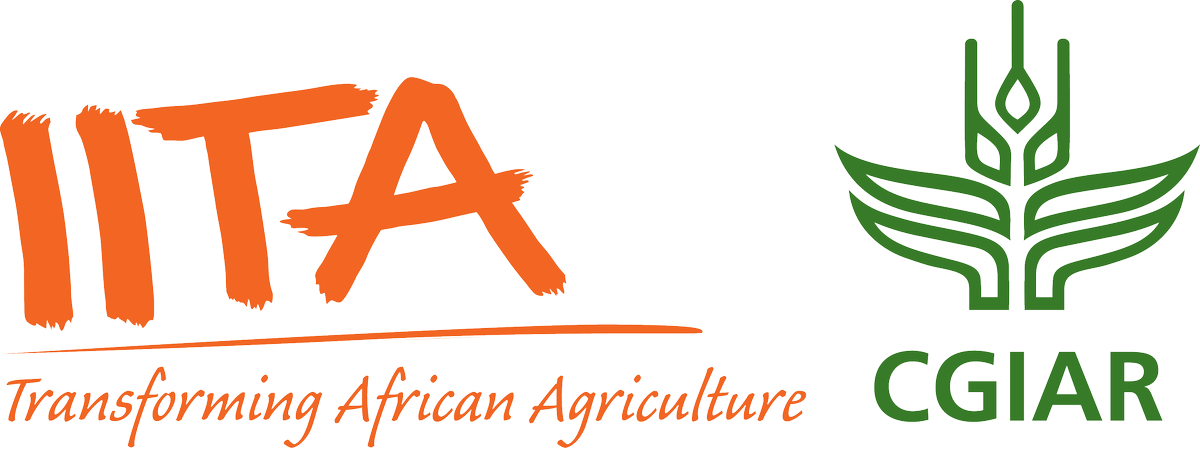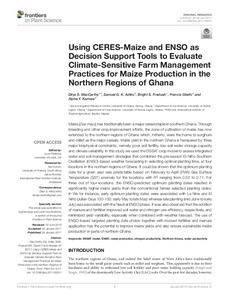| dc.contributor.author | MacCarthy, Dilys S. |
| dc.contributor.author | Adiku, Samuel G.K. |
| dc.contributor.author | Freduah, B.S. |
| dc.contributor.author | Gbefo, F. |
| dc.contributor.author | Kamara, A. |
| dc.date.accessioned | 2019-12-04T11:04:55Z |
| dc.date.available | 2019-12-04T11:04:55Z |
| dc.date.issued | 2017-01-26 |
| dc.identifier.citation | Maccarthy, D.S., Adiku, S.G.K., Freduah, B.S., Gbefo, F. & Kamara, A. (2017). Using CERES-Maize and ENSO as Decision Support Tools to evaluate climate-sensitive farm management practices for maize production in the northern regions of Ghana. Frontiers in Plant Science, 8(31),1-13. |
| dc.identifier.issn | 1664-462X |
| dc.identifier.uri | https://hdl.handle.net/20.500.12478/1526 |
| dc.description | Open Access Journal |
| dc.description.abstract | Maize (Zea mays) has traditionally been a major cereal staple in southern Ghana. Through breeding and other crop improvement efforts, the zone of cultivation of maize has now extended to the northern regions of Ghana which, hitherto, were the home to sorghum and millet as the major cereals. Maize yield in the northern Ghana is hampered by three major biophysical constraints, namely, poor soil fertility, low soil water storage capacity and climate variability. In this study we used the DSSAT crop model to assess integrated water and soil management strategies that combined the pre-season El-Niño-Southern Oscillation (ENSO)-based weather forecasting in selecting optimal planting time, at four locations in the northern regions of Ghana. It could be shown that the optimum planting date for a given year was predictable based on February-to-April (FMA) Sea Surface Temperature (SST) anomaly for the locations with R2 ranging from 0.52 to 0.71. For three out of four locations, the ENSO-predicted optimum planting dates resulted in significantly higher maize yields than the conventional farmer selected planting dates. In Wa for instance, early optimum planting dates were associated with La Nina and El Niño (Julian Days 130-150; early May to late May) whereas late planting (mid June to early July) was associated with the Neutral ENSO phase. It was also observed that the addition of manure and fertilizer improved soil water and nitrogen use efficiency, respectively, and minimized yield variability, especially when combined with weather forecast. The use of ENSO-based targeted planting date choice together with modest fertilizer and manure application has the potential to improve maize yields and also ensure sustainable maize production in parts of northern Ghana. |
| dc.format.extent | 1-13 |
| dc.language.iso | en |
| dc.subject | Farm Management |
| dc.subject | Farmers |
| dc.subject | Dssat Model |
| dc.subject | Enso |
| dc.subject | Maize Production |
| dc.subject | Nitrogen Productivity |
| dc.subject | Northern Ghana |
| dc.subject | Water Productivity |
| dc.title | Using CERES-maize and ENSO as decision support tools to evaluate climate-sensitive farm management practices for maize production in the northern regions of Ghana |
| dc.type | Journal Article |
| dc.description.version | Peer Review |
| cg.contributor.crp | Grain Legumes |
| cg.contributor.crp | Maize |
| cg.contributor.affiliation | University of Ghana |
| cg.contributor.affiliation | International Institute of Tropical Agriculture |
| cg.coverage.region | Africa |
| cg.coverage.region | West Africa |
| cg.coverage.country | Ghana |
| cg.isijournal | ISI Journal |
| cg.authorship.types | CGIAR and developing country institute |
| cg.iitasubject | Grain Legumes |
| cg.iitasubject | Maize |
| cg.iitasubject | Soil Fertility |
| cg.iitasubject | Soil Health |
| cg.journal | Frontiers in Plant Science |
| cg.howpublished | Formally Published |
| cg.accessibilitystatus | Open Access |
| local.dspaceid | 81750 |
| cg.targetaudience | Scientists |
| cg.identifier.doi | https://doi.org/10.3389/fpls.2017.00031 |

